Exploring the Floss Needle in Fashion and Textile Art
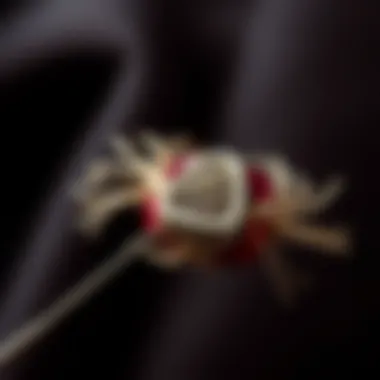
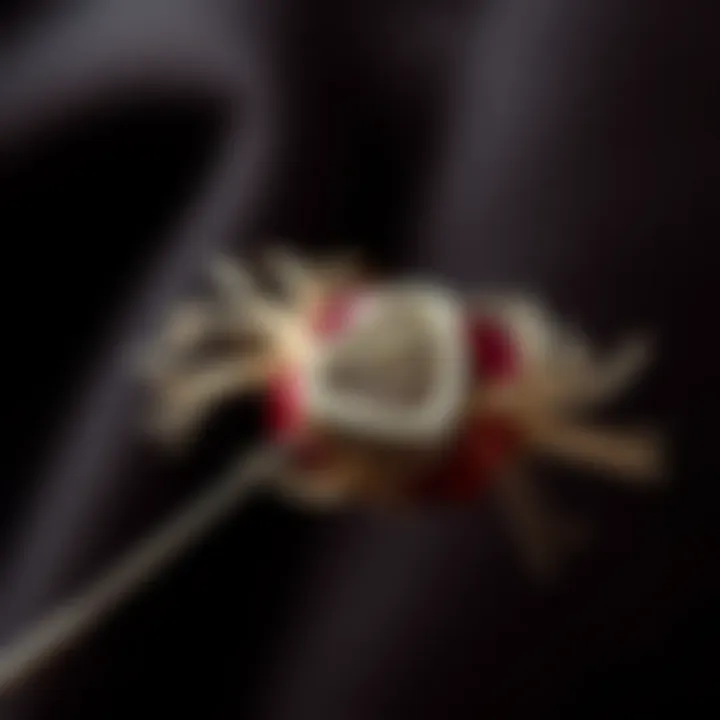
Intro
In the world of fashion and textile artistry, tools often fade into the background, overshadowed by the dazzling creations they help produce. Yet, the floss needle stands out as a distinctive instrument that marries functionality with creativity. This unassuming yet versatile tool is not merely about threading colorful yarn; it encompasses a rich history, innovative applications, and a profound impact on modern design.
The floss needle has seen a resurgence among artisans and hobbyists, serving as a key player in various techniques. From embroidery to intricate fabric manipulation, its role is multifaceted. This article aims to provide a comprehensive look at the floss needle's significance, examining its historical context, current relevance, and innovative uses that charm both seasoned experts and budding enthusiasts alike.
Fashion Trends
Emerging Styles
The floss needle isn't just an accessory for the crafting table; it has found its way into the broader spectrum of fashion trends. Contemporary designers are tapping into the potential this tool offers, weaving it into their collections to create pieces that resonate with both heritage and modernity.
For example, bohemian chic has surged in popularity, showcasing textiles adorned with playful embroidery. Here, the floss needle facilitates elaborate designs that ooze a carefree spirit. Patterns birthed from personal expressions often tell stories, as the needle glides through fabric with ease, inviting wearers to connect with their garments on a deeper level.
In addition to boho influences, we see a shift toward minimalist aesthetics, which appreciate the raw beauty of materials. Fabrics like linen and organic cotton take center stage, while simple hand-stitched details using a floss needle add an artisanal touch that elevates the entire ensemble. These delicate stitches punctuate designs with just the right hint of character, transforming basic outfits into statement pieces.
Seasonal Must-Haves
As fashion seasons shift, so do the applications of the floss needle. For spring and summer collections, vibrant, floral motifs crafted with a light touch of embroidery can breathe life into casual wear. Think pastel tank tops embellished with intricate flowers that stand out without overwhelming the aesthetic.
Meanwhile, autumn and winter trends might lean toward cozy layers and textures. Here, the floss needle can be employed to add warmth and depth to garments. A warm knitted scarf with colorful embroidered edges becomes not only functional but also a work of art in itself. Garments with such detailing enhance comfort while ensuring style doesn’t take a backseat.
Fabric and Sustainability
Eco-Friendly Materials
Navigating the world of fashion today also involves a conscious approach to sustainability. With growing awareness about environmental impacts, textile artists are leaning towards eco-friendly materials. Fabrics made from organic cotton, recycled fibers, and natural dyes are becoming increasingly popular.
Using a floss needle with these materials presents artisans with numerous opportunities to craft beautifully while remaining mindful of their carbon footprints. Hand-stitching details creates a slower, more intentional crafting process, underscoring the notion that quality triumphs over quantity.
The embrace of sustainability resonates deeply with consumers today who prefer brands that reflect their eco-conscious values. Wearers are not just buying clothing; they are investing in art, ethics, and a conscious lifestyle.
Impact of Textile Production
The production of textiles is an intricate process that has both creative and ecological implications. Understanding this impact is vital for any fashion enthusiast or boutique owner. When artisans utilize the floss needle alongside sustainable practices, they contribute to a cycle that honors craftsmanship as much as it does the environment.
Artisanal techniques that highlight this harmony between creativity and sustainability create garments that tell a story of care and intention. As consumers become increasingly conscientious, the demand for such thoughtful creations is likely to grow, driving change in the industry.
"Fashion is not just about clothes; it's about the stories and values they represent."
Thus, the floss needle embodies more than just a tool; it symbolizes a connection to our past, a celebration of modern craftsmanship, and a commitment to crafting a sustainable future in the textile world.
Foreword to Floss Needles
The world of fashion and textile artistry is a rich tapestry woven from creativity, history, and function. At its heart lies a tool that, while simple in appearance, embodies a wealth of cultural and artistic significance: the floss needle. Understanding this tool is not merely about recognizing its physical attributes—it’s about uncovering the myriad ways it has shaped and been shaped by the textile arts.
Defining the Floss Needle
So, what exactly is a floss needle? This specialized needle typically features a larger eye designed to accommodate multiple strands of embroidery floss. Its length and thickness are optimized for various tasks, from delicate embroidery to more robust textile applications. Imagine a painter reaching for a brush, choosing one based on the precision and texture required for the piece; likewise, the floss needle represents a select choice in the realm of stitching.
Although its design may appear straightforward, the nuances in size, material, and tapering can greatly affect the ease with which the needle navigates fabric. For instance, a needle with a sharp tip may pierce fabric seamlessly, while one with a rounded end can create necessary openings with care.
In many ways, the floss needle is more than a tool; it's a bridge linking tradition and innovation. Artisan communities around the globe often employ unique variations of the floss needle. These variations reflect individual cultural practices and techniques that breathe life into every stitch.
The Importance of Needle Selection
When it comes to crafting with textiles, choosing the right needle is as critical as selecting the fabric itself. The elements of material, length, and eye size play significant roles in the functionality and success of a project. For instance, using a needle that is too thick may lead to damaged fibers, while one that is too thin might not accommodate the needed thread effectively.
It’s also about compatibility. Different projects may call for different needle types, and the humble floss needle often stands out as an essential choice for embroidery enthusiasts. Think of a chef choosing the right knife for each ingredient—this same level of careful selection applies here.
Moreover, comfort cannot be overlooked. A needle that fits snugly in one’s hand can mean hours of less strain during intricate stitching tasks. For those working on larger projects, the right floss needle can be the difference between joyful creating and tedious frustration. Notably, it also fosters a more dynamic exploration of design, as the right needle encourages experimentation with various techniques and threads.
Ultimately, understanding the floss needle and the nuances of needle selection can enhance one's crafting experience, leading to improved results and more profound satisfaction from completed projects.
"The right tool makes all the difference in artistic expression; in every stitch lies not just thread, but intention."
For more in-depth insights into needle selection and its impact on textile arts, visit Wikipedia or Britannica.
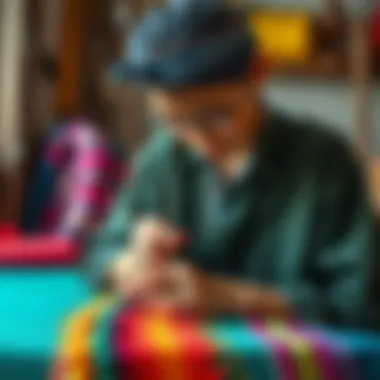
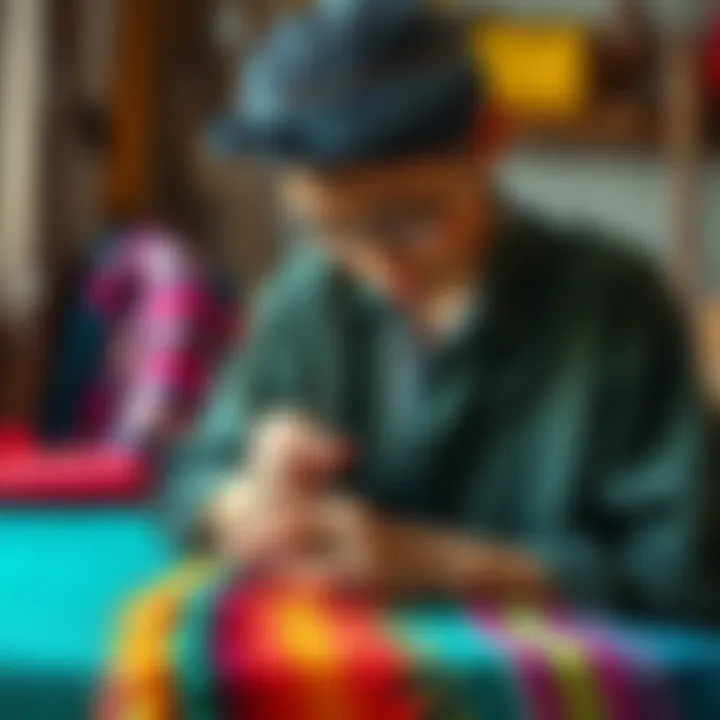
Armed with this foundational knowledge, we can next delve into the fascinating historical perspectives that have shaped the floss needle's evolution and significance.
Historical Perspectives on Floss Needles
Understanding the historical context of floss needles enriches our appreciation for this specialized tool in fashion and textile artistry. It isn’t merely about stitching or threading; it’s about the expression of culture and the evolution of practicality in craft. Every detail in the design and use of floss needles tells a story of innovation, necessity, and artistry, reflecting the values and techniques of different eras and societies.
Evolution Through Time
Floss needles have a significant history that intertwines with the development of textile arts. The journey begins centuries ago, where the need for precision in stitching was apparent. Early versions of these needles traced back to ancient civilizations, where artisans carved out tools from bone or wood, demonstrating that even the basics of creation stem from human ingenuity.
By the Middle Ages in Europe, needle-making became a specialized craft. The production had shifted to metals, marking an advancement in durability and functionality. Medieval seamstresses often carried a range of these tools in their small sewing kits, highlighting their importance in daily life as well as in the creation of elaborate garments worn by nobility.
In the 19th century, the industrial revolution brought about mass production methods, which made floss needles widely accessible. Depending on the needs of the time, different designs emerged: some were longer for intricate embroidery, others shorter for quilting. Each design was adapted to serve its unique purpose, showcasing how functionality has driven innovation.
This evolution reflects a clear narrative—the shift from handcrafted uniqueness to standardized production while still allowing for a personal touch through elaborate needlework techniques. Today, artisans embrace a blend of historical practices with modern aesthetics, ensuring that the floss needle remains relevant and cherished.
Cultural Significance in Various Societies
Delving deeper into the cultural aspects, floss needles resonate within countless societies. In Japan, for instance, the art of sashiko stitching, which employs fine needles, not only embellishes fabric but conveys stories and heritage. With every stitch, narratives of family history and tradition unfold. The meticulous care involved in this form of embroidery fosters a connection between the creator and the cultural memory.
Conversely, in Latin America, embroidery techniques often depict vibrant folklore, turning garments into visual narratives that express identity and community values. The craft transcends mere creation; it embodies a path to share life experiences and societal norms through fabric.
Additionally, regions in Africa have their own rich textile traditions, where the use of needles in creating intricate beadwork shares its own vibrant stories. These diverse practices illustrate how the floss needle serves as an instrument not just of creation but also of celebration. Whether in the form of sashiko, folk embroidery, or intricate beadwork, the needle has played an essential role in expressing and preserving heritage.
The floss needle stands at the crossroads of practicality and artistry, acting as a bridge across histories and cultures, and uniting various forms of creative expression.
In moments of global shifts and social transformations, the continued relevance of the floss needle in textile artistry proves its significance. As we respect these roots, we also pave the way for contemporary interpretations and innovations, ensuring that the craftsmanship will endure for the next generations.
Exploring the historical perspectives of floss needles gives us insight into their multifaceted role in both practical application and cultural expression. In narrative form, these histories intertwine the lives and stories of those who wield them, providing depth to this seemingly simple tool.
Materials and Design of Floss Needles
The choice of materials and design intricacies behind floss needles play a crucial role in their function and effectiveness in textile art. While they may seem like a simple tool used for embroidery and sewing, the details of their construction significantly influence not just the ease of use but the overall quality of the finished product. By understanding the importance of these elements, one can enhance their craft and ensure a superior outcome in any textile project.
Common Materials Used
Floss needles come in a variety of materials which cater to different artistic needs. Here are some commonly employed materials:
- Steel: This is perhaps the most popular choice thanks to its durability and strength. Steel needles, especially those with a nickel finish, resist rust and corrosion, ensuring they last through many projects.
- Aluminum: Lightweight and non-corrosive, aluminum needles are often used in the creative community for their ease of handling and comfort during long sessions of stitching.
- Plastic: Some modern artisans appreciate the use of plastic floss needles, especially when involving younger crafters or those starting out. They tend to be safer and less intimidating, allowing for hesitant hands to find confidence in their stitching endeavors.
- Wood: Often favored by artisans looking for a unique touch, wooden floss needles lend a certain warmth and aesthetic appeal. They can be engraved or decorated, making them not just a tool but also a piece of art in their own right.
Selecting the right material can enhance the stitching experience, just as it can impact the final design. For instance, using steel needles for heavier fabrics ensures that the needle withstands the tension without bending or breaking.
Impact of Design on Functionality
The design of a floss needle is not merely for aesthetics; it serves a vital purpose in its function. Here are several critical aspects of needle design that dictate its usability:
- Eye Size and Shape: The eye of a floss needle should be large enough to accommodate multiple strands of embroidery floss. Needles with a rounded or elongated eye make threading easier and reduce friction, thus preventing fraying of thread.
- Tip Shape: A tapered or sharp tip allows the needle to pierce through fabric with ease. Conversely, a blunter tip might be better for delicate materials, minimizing the risk of damaging the fabric. The choice between these designs can inform how effectively one can work with various materials.
- Length Variation: Needles come in various lengths, and selecting the right size involves more than just personal preference. Longer needles can help cover larger areas more quickly, while shorter needles may offer precision and control, which is vital in intricate designs.
- Grip Features: Some modern needles boast ergonomic designs or textured grips. This can make a world of difference for those who engage in sewing for extended periods of time, as it can reduce hand fatigue and make stitching more comfortable.
In summary, while the beauty of the craft lazes in creativity, effective tools are paramount to transforming vision into reality. By selecting the right materials and understanding the function behind designs in floss needles, creators can set themselves up for success in their textile artistry.
Practical Applications in Textile Arts
The floss needle serves a multifaceted purpose in the world of textile arts. Its unique design allows artisans to explore a range of creative avenues, making it an indispensable tool in the stitching brigade. The exploration into practical applications highlights not only its functional attributes but also the artistic avenues it opens up for creators of various backgrounds. Whether you are crafting a delicate embroidered piece or piecing together a quilt, understanding the benefits and specific applications of the floss needle can elevate the craftsmanship and enrich the final product.
Use in Embroidery and Handwork
In the realm of embroidery, the floss needle shines as an essential instrument. This tool, characterized by its larger eye and slender shaft, facilitates the passage of multiple strands of floss, making threaded transitions seamless. Tailors and hobbyists alike have benefitted from its efficacy in different stitch types, ranging from simple back stitches to intricate satin ones. The precision offered by the floss needle enhances detailed patterns and allows for better control over thread tension.
One standout advantage is its ability to work smoothly on various fabric types—from sheer silks to stiffer canvases—making it versatile enough for any embroidery project. Furthermore, the ease of handling means less frustration for the artisan, paving the way for an enjoyable crafting experience.
"The right needle can make all the difference in zeroing in on detail and creativity."
For those keen on experimenting, embroidery techniques such as thread painting and free motion embroidery are excellently suited to the floss needle's capabilities. Crafting personalized pieces, such as monogrammed gifts, is another avenue where this needle can truly shine.
Floss Needles in Quilting Techniques
Quilting enthusiasts have discovered that using the correct needle type significantly influences the final appearance and durability of a quilt. Floss needles find favor here, especially in projects involving multiple fabric layers. The increased eye size allows for multiple strands, which is crucial for creating bold, vibrant quilting patterns.
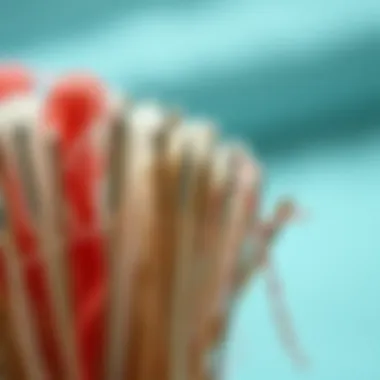
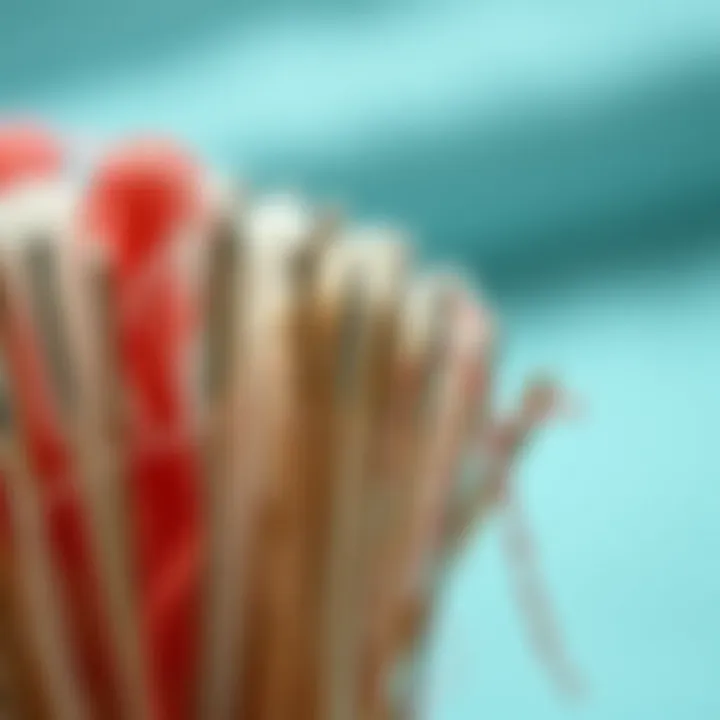
Utilizing a floss needle can help quilters infuse personality into their works. Techniques such as big stitch quilting depend on a needle that accommodates heavier thread, enhancing the tactile and visual features of the final quilt. As quilters often combine various fabrics, the floss needle facilitates better maneuvering through thick layers, mitigating the risk of breakage or misaligned stitches.
In addition, considering the warmer look that larger stitches can bring, many contemporary artists are opting for visible stitching as a design choice, thus blending traditional methods with modern aesthetics.
Innovative Applications in Fashion Design
The applications of floss needles extend beyond mere textiles and into the realm of fashion design, where they contribute to innovative practices. Fashion designers increasingly regard floss needles as pivotal instruments for adding intricate details to garments. In a world that values unique expression, the versatility of this needle enables the melding of classic embroidery techniques with modern silhouettes and avant-garde designs.
From embellished necklines to statement sleeves, the floss needle allows for the seamless integration of embroidery into garment construction. Many designers utilize these needles in couture collections, leveraging them to create not just functional pieces but also wearable art forms.
Sustainable fashion is another frontier ripe for exploration, as creators turn to embroidery to enhance vintage pieces or to provide ethical flair to newer ones. By employing a floss needle, designers recycle materials, stitching together patches or intricate designs that tell a story—making each piece a canvas for personal expression and sustainability.
Thus, the floss needle, with its practical benefits and artistic potential, emerges as a central player in the evolving narrative of textile arts. Embracing its capability not only shortens the gap between functionality and creativity but also encourages artistry that resonates with modern sentiments.
Techniques and Best Practices
Understanding techniques and best practices for using floss needles is key to maximizing their potential in fashion and textile artistry. Mastering these methods leads to greater efficiency and creativity, allowing artisans to blend tradition with innovation seamlessly.
Effective Threading Techniques
One of the fundamental skills to grasp when working with floss needles is effective threading. Getting the thread through the needle's eye may seem straightforward, but there are nuances. Start with a strong but flexible thread. Choose a thread that won’t fray easily; cotton or polyester embroidery threads are excellent options.
Here’s a straightforward method to thread a floss needle:
- Cut the Thread: Trim a clean, straight edge. A bias cut often helps.
- Moisten the End: A quick lick can make the threading much easier by allowing the strands to stick together.
- Insert the Thread: Gently pass the thread through the eye before pulling it.
- Avoid Twisting: Keep the thread as straight as possible to avoid tangling.
Additionally, some artisans find using a needle threader invaluable, particularly when dealing with multiple strands or fine threads. The technique not only saves time but also helps maintain focus on the creative process without wrestling with tangled threads.
"A well-threaded needle is not just a tool; it's a bridge between intention and creation."
Combining Floss With Other Materials
The beauty of floss needles extends beyond just embroidery or simple stitching; the potential for combining floss with other materials is where excitement lies. This practice can expand the capabilities of a project significantly, allowing for unexpected textures and visual intrigue. Here are a few considerations when diving into this area:
- Layering Materials: Combining fabrics such as felt, mesh, or even leather with floss can create unique dimensional pieces. For instance, stitching floss onto leather not only enhances durability but also offers a rustic charm.
- Incorporating Beads or Charms: Adding beads or other embellishments into your floss work can electrify an otherwise simple design. Thread these alongside the floss to introduce a new beaded texture that can catch the eye.
- Playing with Color and Patterns: Experimentation is key. Using a gradient of threads alongside contrasting materials can yield artwork where the thread resonates with the base material, creating striking cohesion.
When it comes to combining floss with other materials, the only limit is your imagination. Techniques like free-motion stitching or trapunto can further enhance the visual appeal of a piece, making it stand out in an increasingly saturated market. The practice allows artists to explore the interplay of different materials, ultimately enriching the artistic expression within their textile work.
Floss Needles in Modern Fashion
In today's vibrant landscape of fashion and textile artistry, the floss needle stands not only as a simple tool but as an embodiment of creativity and functionality. With the rise of individual expression in fashion, the traditional aspects of needlework have found a new life with the influx of contemporary styles and innovative adaptations. The significance of floss needles in modern fashion can't be overstated; they have become crucial in the ongoing dialogue about craftsmanship and sustainable practices.
Recent Trends in Use
Around the globe, fashion designers are increasingly incorporating floss needles into their collections, fostering a kinship between artisan skill and modern aesthetics. One notable trend is the revival of hand-stitched elements in high-end fashion. Designers like Isabel Marant have showcased garments adorned with delicate embroidery, making use of floss needles to add texture and depth. These pieces often feature intricate designs that reflect regional patterns or personal narratives.
Furthermore, the use of floss needles extends beyond fashion design into the realms of DIY projects and bespoke tailoring. Young creators are taking to social media platforms like Instagram and Pinterest to share their unique designs and techniques. This digital sharing has ignited a passion for personalized fashion, propelling individuals toward embracing their skills with floss needles. This movement celebrates not just the final product, but the process involved in creating it. The hashtag #HandmadeFashion often garners thousands of views, highlighting a significant cultural shift toward valuing handmade methods.
Influence on Sustainable Fashion Practices
The role of floss needles in sustainable fashion cannot be overlooked. As consumers lean more towards eco-friendly choices, artisans and designers are responding by integrating traditional craftsmanship into their production processes. Many creators are repurposing fabric scraps and using remnants from past collections, stitching them together with floss needles to build new garments that tell a story of past lives. This practice not only minimizes waste but also infuses each piece with a unique history, elevating the overall value of the fashion being produced.
Moreover, the handmade quality that comes along with using floss needles appeals to the growing market of conscious consumers. Customers are increasingly seeking items that are not mass-produced, opting instead for garments that have been crafted with care. This trend is evident in labels that advertise their commitment to using sustainable practices alongside artisanal techniques.
"Incorporating individual craftsmanship into fashion not only benefits the environment but also resonates with consumers' desire for meaningful purchases."
Artisanship is also spilling over into collaborations between brands and local artisans. Fashion houses are partnering with skilled embroidery artists to create limited edition lines that emphasize handwork. By doing so, they not only highlight the deftness of the craft but also offer designers and seamstresses a platform to showcase their work on a larger scale. This ongoing exchange between traditional needlework and fashion underscores a movement towards more sustainable and thoughtful production methods.
As the world of fashion continues to evolve, floss needles are proving to be more than just tools; they are catalysts for change, driving conversations about sustainability, artistry, and the intrinsic value of handcrafted goods.
Comparative Analysis with Other Needles
In the world of sewing and textile artistry, the multitude of needle types available might overwhelm even the most seasoned craftsperson. Among these tools, the floss needle occupies a niche that sets it apart from its peers. A comparative analysis with other needles sheds light not only on its unique design and function but also on its distinctive benefits, helping enthusiasts to better appreciate its role in their fabric manipulation endeavors.
Differences and Similarities in Functionality
A first glance at needles like the universal sewing needle or the tapestry needle may suggest they share more similarities with the floss needle than they do differences. Commonly, all needles are designed to pierce fabric, but each possesses specific features tailored to different tasks.
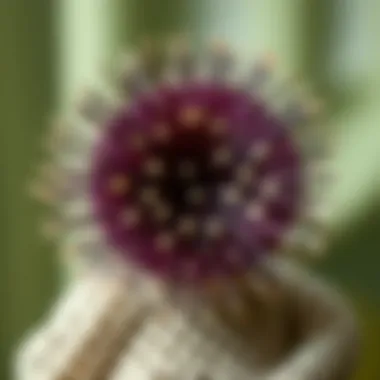
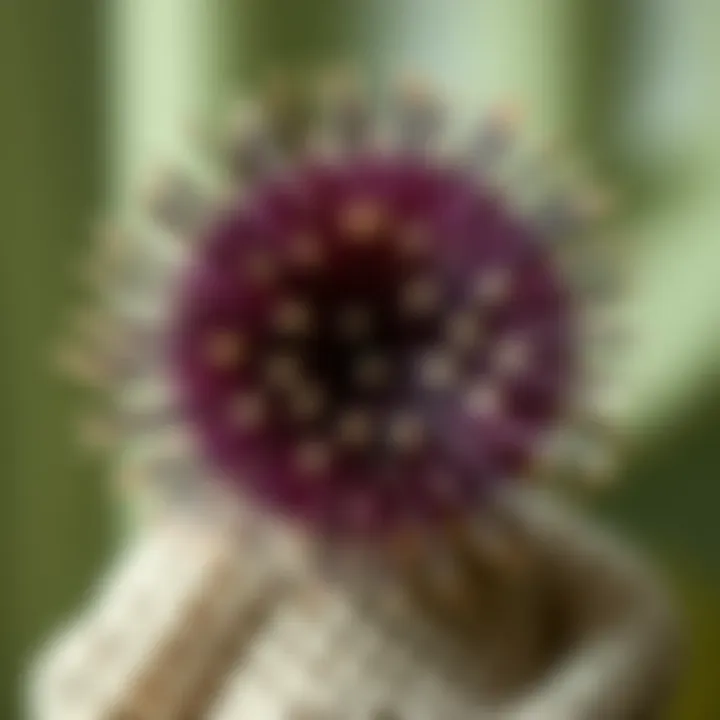
Floss needles are generally longer, with a larger eye meant to accommodate multiple strands of embroidery floss. This characteristic allows for the delicate layering and intricate stitching that is often sought after in creative embroidery projects. In contrast, a universal needle is versatile for basic sewing, while a tapestry needle, with its blunt tip, is optimized for needlepoint and cross-stitch work.
- Floss Needle Features:
- Universal Needle Features:
- Larger eye for thicker threads.
- Longer length for extensive reach in fabric.
- Sharper point for ease in piercing woven materials.
- Standard size for general sewing purposes.
- One single eye size fits most threads.
- Adjustable length for versatility.
Despite these differences, some functionalities overlap. For instance, all needles can be used to create stitching patterns and join pieces of fabric. However, using the appropriate needle for specific projects significantly enhances precision and quality of the work.
Specialized Tools vs. General Needles
When we talk about specialized tools, the floss needle exemplifies the notion that sometimes, less is more. It serves dedicated purposes while general needles can be jack-of-all-trades, often falling short in more specific applications. A specialized needle like the floss needle is meticulously crafted for particular uses in embroidery or decorative stitching, allowing artisans to achieve effects that general needles simply cannot replicate.
The craftsmanship put into each floss needle—considering its dimensions, material, and eye size—enhances usability, leading to smoother stitching and greater artistic outcomes. In contrast, a general needle often demands compromises in technique, making the final product less than ideal. Using a specialized tool can often save time and frustration, letting creativity flow with fewer hiccups.
To summarize the key points:
- Use a floss needle for:
- General needles are better for:
- Multi-strand embroidery and stitching.
- Applications requiring thicker threads.
- Achieving detailed, intricate designs.
- Everyday sewing tasks.
- Quick fixes and alterations.
Ultimately, understanding these distinctions allows seamstresses and designers to select the right needle for their projects, fostering creativity and precision in their textile artistry. As we progress through the information available about floss needles, the choice of the right tools expands, enhancing the creativity and individuality in fashion and textile artistry.
"Choosing the right needle isn’t just about the task; it’s about the passion you weave into every stitch."
For further reading on needle types and uses, you can explore Wikipedia or delve deeper into articles on sewing techniques at Britannica.
Teaching and Learning Resources
The journey of mastering the floss needle is not just about personal practice; it also heavily relies on available resources designed to support and elevate individuals in their creative endeavors. Workshops, classes, and online tutorials play a crucial role in safeguarding the techniques and traditions associated with floss needle use. By engaging with such resources, learners can deepen their understanding and enhance their skills in textile art, contributing to a larger community of fashion enthusiasts and artisans.
Workshops and Classes Focusing on Floss Needles
Participating in hands-on workshops offers a unique opportunity for learners to interact directly with experienced instructors who can provide insights that books or videos might miss. These gatherings, often hosted in local textile shops or community centers, allow for collaborative learning. Participants can share ideas, troubleshoot issues, and gain immediate feedback on their projects.
- Benefits of Attending Workshops:
- Direct Feedback: Instructors can offer tailored advice based on individual skill levels, addressing specific challenges that a learner may face.
- Networking: Meeting fellow peers creates a space for exchanging ideas and fostering future collaborations.
- Hands-On Experience: Techniques learned in a classroom setting often lead to quicker mastery, as the tactile nature of working with materials cannot be replicated online.
A variety of workshops are conducted across different regions, some emphasizing basic embroidery while others might delve into complex quilting or mixed-media art. Local universities and art schools may also offer short courses that include sections focusing on the floss needle, helping to diversify the skills one acquires.
Online Tutorials and Community Engagement
The digital age has ushered in a new paradigm for learning, particularly for those interested in niche skills like using a floss needle. Online tutorials provide instant access to a wealth of knowledge that can be fantastic for self-paced learners. These tutorials, often paired with video demonstrations, break down techniques step-by-step and can be accessed from the comfort of one’s home. Platforms like YouTube and dedicated crafting websites host an abundance of instructional content that covers everything from the fundamentals to advanced methods.
Engaging with online communities, such as dedicated Reddit forums or Facebook groups, allows learners to seek advice, share their creations, and even participate in challenges that motivate further development.
- Advantages of Online Engagement:
- Diverse Learning Materials: While workshops may be limited to the instructor’s knowledge, online content reflects a wide array of techniques and styles.
- Accessibility: Many resources are free or low-cost, opening doors for individuals who might be unable to attend physical classes due to distance or finances.
- Global Community: Engaging with people worldwide can inspire new ideas and broaden one’s understanding of how different cultures utilize floss needles in their textile art.
By tapping into these resources, aspiring textile artists can not only refine their skills but also firmly establish their place within a vibrant community of creators who share a passion for the art of sewing and embroidery.
Through a combination of workshops, classes, online tutorials, and communal interactions, the knowledge surrounding floss needles continues to flourish, ensuring that both practical application and artistic expression remain alive and well in the ever-evolving landscape of fashion and textile artistry.
Finale
In closing, the exploration of floss needles reveals their remarkable significance in both fashion and textile arts. These simple tools have emerged as more than mere instruments; they represent a bridge between functionality and creativity, offering artisans countless possibilities for expression. The diverse applications of floss needles not only enhance the aesthetic quality of fabric creations but also promote sustainable practices in the textile industry.
Reflecting on the Role of Floss Needles
Looking back, it’s clear that floss needles have played a pivotal role in different cultures. The ability to create intricate patterns and designs using these needles speaks volumes about the artistry involved in textile work. Craftspersons often find that utilizing a floss needle can make the difference between a basic piece and a breathtaking one. This tool does not just facilitate the stitching process; it inspires innovation and skill growth among crafters.
Moreover, the attention to detail that floss needles enable contributes to a more thoughtful approach to garment-making. Fashion enthusiasts often heed this notion, recognizing that the tools they employ can elevate their work. For boutique owners, understanding the function and artistry behind floss needles adds another layer to their business. They can better educate their customers, turning simple garments into stories rich with cultural heritage and artistic merit.
Future Trends in Textile Arts
As we gaze into the future, the integration of technology with traditional needlecraft takes center stage. Innovations such as smart stitching methods and automated craft devices may soon change the landscape of how floss needles are used. However, it’s critical that while we adopt these advancements, we continue to respect and preserve the artisanship that comes with hand-stitched creations.
Additionally, the trend towards sustainability in fashion encourages the use of natural and eco-friendly materials in combination with floss needles. More artisans are opting to use organic threads and recycled fabrics, marrying contemporary environmental concerns with age-old practices.
In essence, the future of floss needles in textile arts seems bright, with potential for growth and new techniques on the horizon. As artisans and designers continue to embrace both tradition and innovation, the possibilities of what can be achieved with this humble but vital tool will only expand. As a community, we must keep nurturing that spirit of creativity and exploration that lies at the heart of this craft.







